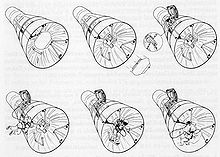Astronaut Maneuvering Unit
The Astronaut Maneuvering Unit ( AMU ) was a rocket backpack developed for the Gemini spacesuit as part of the Gemini program . However, it was never actively used in space.
Calls
Gemini 9
The AMU was to be used for the first time during the Gemini 9 mission . The AMU was attached to the stern of the Gemini spaceship under a special cover in the adapter ring . For example , after leaving the Gemini capsule , Eugene Cernan had to use the handles to shimmy back to the stern and stand on steps to put on the AMU. Before that, he threw off the cover with his hand because the automatic separation by pressing a button from inside the space capsule did not work. When the radio communication deteriorated, the spacecraft disappeared into the shadow of the earth and the Cernan's visor fogged up so much due to the cold in the shadow of the earth and the increased exertion that he could hardly see anything , the action was stopped at Tom Stafford's suggestion, so that the multi-million dollar rocket backpack burned up unused in the earth's atmosphere at the end of the mission.
With the AMU, Cernan should float completely free through space according to the plans of the United States Air Force , but NASA insisted on a 45 m long safety line. In order to prevent the nozzles of the rocket backpack from damaging the space suit that the astronauts wore during their space exits , it had to be reinforced.
Skylab 3
A second version was used in 1973 during the Skylab 3 mission. Here, however, the rocket backpack inside the Skylab space station was tested. Because of this, it was operated with nitrogen instead of hydrogen peroxide , as this would cause less damage to Skylab in the nitrogen-oxygen atmosphere.
Technical specifications
- Developed for the United States Air Force
- Mass: 75 kg
- Height: 81 cm
- Width: 56 cm
- Depth: 48 cm
- Fuel: hydrogen peroxide (the second version used nitrogen as fuel )
- Speed: max. 76.2 m / s
- Compressed gas nozzles: 16 (allow free movement in space)
- Cost: 24,000,000 DM
- Controls: 2 sticks
You could also strap yourself in in the seat.
Individual evidence
- ↑ a b c Kenneth S. Thomas, Harold J. McMean: US Spacesuits . Springer, Berlin / Heidelberg / New York, ISBN 0-387-27919-9 , pp. 70-74 .
- ^ A b Matthias founder, Horst Hoffmann, Gerhard Kowalski: SOS in space . Schwarzkopf & Schwarzkopf, 2001, ISBN 3-89602-339-X , p. 76-79 .
- ↑ a b Bernd Leitenberger: The Gemini program . Books on Demand, 2008, ISBN 978-3-8370-2968-0 , pp. 50-51 .



